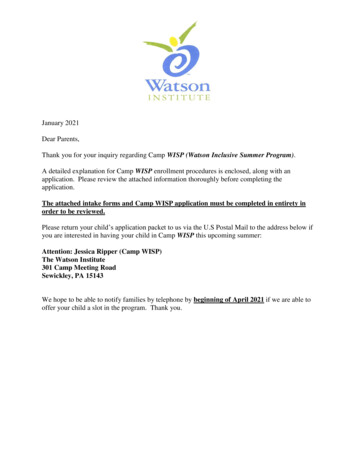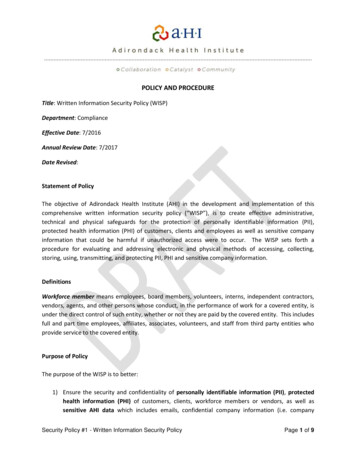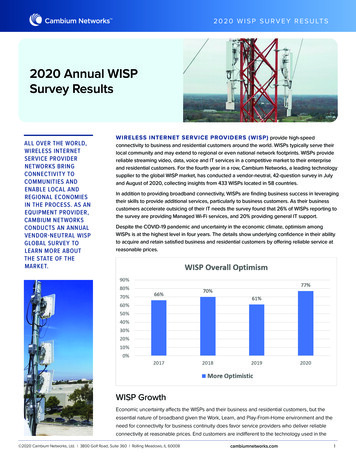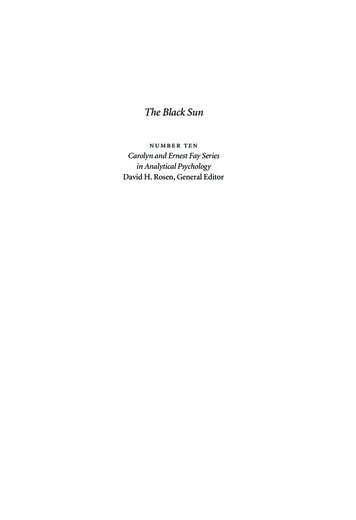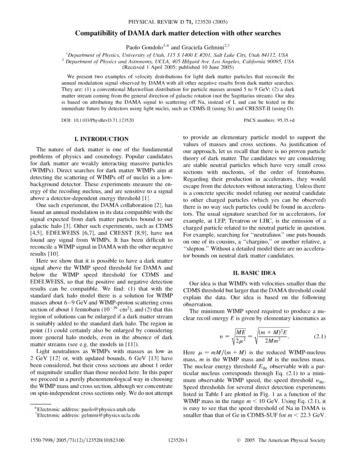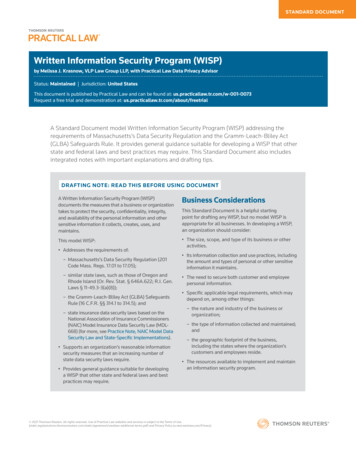
Transcription
WISP Dark Matter eXperiment and Prospectsfor Broadband Dark Matter Searches in the 1 µeV–10 meV Mass RangeDieter Horns1 , Axel Lindner2 , Andrei Lobanov3,1,† , Andreas Ringwald21Institut für Experimentalphysik, Universität Hamburg, GermanyDeutsches Elektronen-Synchrotron (DESY), Hamburg, Germany3Max-Planck-Institut für Radioastronomie, Bonn, Germany†corresponding author.2DOI: v andreiLight cold dark matter consisting of weakly interacting slim (or sub-eV) particles (WISPs)has been in the focus of a large number of studies made over the past two decades. TheQCD axion and axion-like particles with masses in the 0.1 µeV–100 meV are strong candidates for the dark matter particle, together with hidden photons with masses below. 100 meV. This motivates several new initiatives in the field, including the WISP DarkMatter eXperiment (WISPDMX) and novel conceptual approaches for broad-band WISPsearches using radiometry measurements in large volume chambers. First results and futureprospects for these experiments are discussed in this contribution.1WISP dark matter searches in the 1 µeV–10 meV massrangeSearches for light cold dark matter (DM) consisting of weakly interacting slim particles (WISPs) [1,2, 3, 4] are gaining prominence, with a number of experiments conducted and proposed detecting hidden photons (HPs), QCD axions, and axion-like particles (ALPs) with astrophysical [5, 6, 7, 8, 9, 10, 11] and laboratory measurements [12, 13, 14, 15, 16, 17].Best revealed by their coupling to standard model (SM) photons, WISPs can be nonthermally produced in the early Universe [18] and may give rise to dark matter for a broadrange of the particle mass and the photon coupling strength [19, 20]. The photon coupling ofaxions/ALPs, gaγ 1/fa , depends on the energy scale fa of the symmetry breaking responsiblefor the given particle, while the hidden photon coupling, χ gh , is determined by the hiddengauge coupling, gh [19].At particle masses above 10 3 eV, the existing constraints effectively rule out WISPs asDM particles, while cosmologically viable lower ranges of particle reach down to 10 6 –10 7 eVfor axions/ALPs and may extend to much lower masses with for HP and ALP, as well as with“fine tuning” of the axion models. The mass range 10 7 –10 3 eV corresponds to the radioregime at frequencies of 24 MHz–240 GHz where highly sensitive measurement techniques aredeveloped for radioastronomical measurements, with typical detection levels of . 10 22 W.Patras 2014941PATRAS 2014
WISP DARK M ATTER E X PERIMENT AND P ROSPECTS FOR B ROADBAND DARK . . .2Narrowband experimentsThe most sensitive laboratory HP and axion/ALP DM searches performed so far in the massrange 10 7 –10 3 eV have utilised the “haloscope” approach [21] which employs resonant microwave cavities lowering substantially the detection threshold in a narrow band around eachof the cavity resonances [12, 13, 14, 22, 23, 24]. The WISP DM signal results from conversionof DM halo particles inside the cavity volume, V , into normal photons. This conversion isachieved via spontaneous kinetic mixing of HP with SM photons or via the Primakov processinduced by an external magnetic field, B, for axions/ALPs.The output power of the axion/ALP conversion signal is Pout G Q V B 2 , where Q is theresonant enhancement factor (quality factor) of microwave cavity and G is the fraction of cavityvolume (form factor) in which the electric field of the converted photon can be detected [25, 26].Both G and Q depend on the cavity design and the resonant mode employed in the measurement.The respective Pout for the HP signal does not have a dependence on B.The fractional bandwidth of a haloscope measurement is Q 1 , with typical values of Qnot exceeding 105 . The WISP DM signal itself is restricted to within a fractional bandwidth22 6of Q 1, with σDM describing the velocity dispersion of the dark matter halo.DM σDM /c 10A measurementmadeatafrequency, ν, and lasting for a time, t, can detect the WISP signal atpan SNR t / W Pout /(kb Tn ), where W is the signal bandwidth, Tn is the noise temperatureof the detector, and kb is the Boltzmann constant.The exceptional sensitivity of microwave cavity experiments comes at the expense of ratherlow scanning speeds of . 1 GHz/year [12, 27], which makes it difficult to implement this kind ofmeasurements for scanning over large ranges of particle mass. To overcome this difficulty, newexperimental concepts are being developed that could relax the necessity of using the resonantenhancement and working in a radiometer mode with an effective Q 1 [16, 17, 28, 29, 30].2.1WISP Dark Matter eXperimentAt frequencies below 1 GHz, the ADMX experiment[12, 13, 14] has employed the haloscopeapproach to probe the HP and axion/ALP dark matter in the 460–860 MHz (1.9–3.6 µeV)range [31], and a high frequency extension, ADMX-HF is planned for he 4–40 GHz frequencyrange [32, 33]. The WISP Dark Matter eXperiment (WISPDMX, Fig. 1) extends the haloscopesearches to particle masses below 1.9 µeV, aiming to cover the range 200–600 MHz (0.8–2.5 µeV).WISPDMX utilises a 208 MHz resonant cavity of the type used at the proton acceleratorring of the DESY HERA collider [34]. The cavity has a volume of 460 liters and a nominalresonant amplification factor Q 55000 at the ground TM010 mode. The signal is amplified bya broad-band 0.2–1 GHz amplifier chain with a total gain of 40 dB. Broad-band digitization andFFT analysis of the signal are performed using a commercial 12-bit spectral analyzer, enablingsimultaneous measurements at several resonant modes at frequencies of up to 600 MHz.The main specific aspects of WISPDMX measurements are: 1) broadband recording in the200–600 MHz band at a resolution of 150 Hz, 2) the use of multiple resonant modes tuned bya plunger assembly consisting of two plungers, and 3) the planned use of rotation of the cavityin the magnetic field in order to enable axion measurements at multiple resonant modes as well.The WISPDMX measurements are split into three different stages: 1) HP DM searches atthe nominal frequencies of the resonant modes of the HERA cavity; 2) HP DM searches withcavity tuning (covering up to 70% of the 200–600 MHz band); and 3) axion/ALP DM searchesusing the DESY H1 solenoid magnet which provides B 1.15 T in a volume of 7.2 m3 .2PATRAS 2014Patras 201495
A NDREI L OBANOVFigure 1: WISPDMX setup for the initial measurements made at nominal resonant frequenciesof the microwave cavity. Indicated with numbers are: 1 – a 208-MHz microwave cavity of thetype used in the proton ring of the DESY HERA collider; 2 - cavity ports (two on the axis of thecavity and five on the radial wall of the oblate cylinder; 3 – antenna ports for two magnetic-loopantennas inserted in the cavity; 4 – first stage amplifier (WantCom, 0.1-1.0 GHz, 22.5 dB gain,0.6 dB noise figure); 5 – second stage amplifier (MITEQ, 0.1-0.9 GHz, 18.2 gain, 1.0 dB noisefigure); 6 – network analyzer (HP 85047A); 7 – control computer, with a 12-bit digitizer AlazarATS-9360 operated via a PCIe Gen2 interface.The first phase of the WISPDMX measurements has been completed [15], and the finalresults are being prepared for publication. The WISPDMX setup used for these measurementsis shown in Fig. 1. Table 2.1 lists preliminary exclusion limits obtained for five different resonantmodes of the cavity. These limits reach below χ 3 10 12 at all of the modes used in themeasurement, and already these limits probe the parameter space admitting HP DM. Theexpected exclusion limits for the HP and axion/ALP DM searches in the next two phases ofWISPDMX are shown in Figs. 2-3.3Broadband experimentsThe relatively low scanning speed (e.g., 100 MHz/yr for WISPDMX and 1 GHz/yr forADMX) and limited tunability of resonant experiments make them difficult to be used forcovering the entire 1 µeV–10 meV range of particle mass. The gain in sensitivity provided bythe resonant enhancement, Q, needs to be factored against the bandwidth reduction of thePatras96 20143PATRAS 2014
WISP DARK M ATTER E X PERIMENT AND P ROSPECTS FOR B ROADBAND DARK . . .Table 1: WISPDMX measurements at nominal resonant modes in the 200-600 MHz 0.0360.037Pdet[ 10 14 .38872742.3955906χ[ 10 13 ]17.08.48.510.128.229.520.419.1Column designation: resonant mode of the cavity, with its respective resonant frequency, ν, qualityfactor, Q, geometrical form factor, G, measured noise power, Pdet , hidden photon mass, mγs , and 95%exclusion limit, χ, for hidden photon coupling to normal photons, calculated for the antenna couplingκ 0.01 [15].order of Q 1 , which may result in a somewhat counterintuitive conclusion that non-resonant,broadband approaches may be preferred when dealing with a mass range spanning over severaldecades.Indeed, for axion/ALP searches, reaching a desired sensitivity to the photon coupling implies2a measurement time t TsysB 4 V 2 G 2 Q 2 . A broadband measurement, with Qb 1, needs2to last Q times longer to reach the same sensitivity. However, the broadband measurementprobes the entire mass range at once, while it would require a (potentially very large) numberof measurements, Nmes 1 log(α) / log[Q/(Q 1)], in order to cover a range of particle massfrom m1 to m2 α m1 (with α 1). Then, the broadband approach would be more efficientin case if tb tn Nmes . This corresponds to the following comparison between these two typesof measurement: 2 4 2 2TbBbVbGb1 Q log α ,TnBnVnGnwhere the subscripts b and n refer to the respective parameters of the broadband and narrowband measurements. For typical experimental settings, one can expect that Tb 100 Tn ,Bb Bn , Vb 100Vn , and Gb 0.01Gn . In such conditions, a narrowband experiment withQ 104 / log α would be less efficient in scanning over the given range of mass. Applied to theentire 0.1 µeV–10 meV range of mass, this condition implies restricting the effective resonanceenhancement of narrowband measurements to less than 2000, which effectively disfavors thenarrowband approach for addressing such a large range of particle mass.The measurement bandwidth of radiometry experiments is limited only by the detectortechnology, with modern detectors employed in radio astronomy routinely providing bandwidthsin excess of 1 GHz and spectral resolutions of better than 106 .One possibility for a radiometer experiment is to employ a spherical dish reflector thatprovides a signal enhancement proportional to the area of the reflector [16, 28, 29, 30]. Thisoption is well-suited for making measurements at higher frequencies (shorter wavelengths, λ),as the effective signal enhancement is Adish /λ2 , where Adish is the reflecting area [16]. It istherefore expected that this concept would be best applicable at λ . 1 cm (ν & 30 GHz).4PATRAS 2014Patras 201497
A NDREI L OBANOVDark Radiation-6LSW-12Cold DMHaloscopesADMXCERNADMXLog10 ΧCMBHidden HiggsHmHh »mý ' L-9TSLSWCoulombHHelioscope IPS IXENONUWAALPS-IILSWStückelberganisotropicicrg meterChamber-18-6-4Log10 mΓs @eVDFigure 2: Exclusion limits for hidden photon coupling to normal photons from existing (whitecaptions) and planned (black captions) experiments (adapted from [4]). Theoretical expectations for the hidden photon DM are indicated in red. The expected sensitivity limits of thesecond phase of the WISPDMX experiment are marked with turquoise color, reaching well intothe DM favored range of photon coupling. The WISPDMX sensitivity is calculated for a setupwith two tuning plungers operating simultaneously. The hatched areas illustrate the expectedsensitivity of broadband experiments using the spherical reflector and the radiometry chamberapproaches.At lower frequencies, another attractive possibility for engaging into the broadband measurements is to use the combination of large chamber volume and strong magnetic field providedby superconducting TOKAMAKs or stellarators such as the Wendelstein 7-X stellarator [35] inGreifswald (providing B 3 T in a 30 m3 volume).3.1Radiometry chamber experimentsMore generally, the stellarator approach signifies a conceptual shift to employing a large, magnetized volume of space which can be probed in a radiometry mode (radiometer chamber),without resorting to a resonant enhancement of the signal. The exclusion limits expected tobe achievable with the spherical reflector experiments and with the measurements made in aradiometer chamber with the volume and magnetic field similar to those of the Wendelsteinstellarator are shown in Fig. 2-3.Deriving from the stellarator approach, a large chamber can be designed specifically for theradiometer searches, with the inner walls of the chamber covered by multiple fractal antennaelements providing a broad-band receiving response in the 0.1-25 GHz frequency range with ahigh efficiency and a nearly homogeneous azimuthal receiving pattern [36, 37]. CombinationPatras98 20145PATRAS 2014
WISP DARK M ATTER E X PERIMENT AND P ROSPECTS FOR B ROADBAND DARK . . .-6-12ADMXTeV TransparencyWD cooling hintRadiometerChamberHaloscopesHelioscopes HCASTL-9Log10 g @GeV-1 DYMCELSW HALPS-ILALPS-II,REAPRALP CDMSN Γ-burstIAXOaxion CDMADMX-HFWISPDMX-15ADMXKSVZ-18Spherical Reflectoraxion-6-4Log10 ma @eVDFigure 3: Exclusion limits for axion/ALP photon coupling to normal photons from existing(white captions) and planned (black captions) experiments (adapted from [4]). The yellow bandcorresponds to the parameter space allowed for the QCD axion. Theoretical expectations forthe axion/ALP DM are indicated in red. The expected sensitivity limits of the second phase ofthe WISPDMX experiment are marked with turquoise color, reaching well into the DM favoredrange of ALP coupling. The WISPDMX sensitivity is calculated for a setup with two tuningplungers operating simultaneously. The hatched areas illustrate the expected sensitivity ofbroadband experiments using the spherical reflector and the radiometry chamber approaches.of multiple receiving elements provides also the possibility for achieve directional sensitivity tothe incoming photons.The directional sensitivity can be realized through high time resolution enabling phase difference measurements between individual fractal antenna elements. Making such measurementsis well within the reach of the present day data recording implemented for radio interferometricexperiments with the recording rate as high as 16 Gigabit/sec [38]. This recording rate providesa time resolution down to 0.12 nanoseconds, thus enabling phase measurements over effectivetravel path difference δl 4 millimetres. This corresponds to an angular resolution φp in therange of R/(L/δl 1)[(R2 L2 )1/2 δl ] 1 . φp . (2R/δl 1)1/2 /(R/δl 1), where R and Ldenote the smallest and largest dimensions of the chamber, respectively. For a chamber fittedinto the HERA H1 magnet (assuming R 1 m and L 3 m), this corresponds to angularresolutions of 0.05 . φp . 5 . The radiometry chamber measurements could therefore providean attractive experimental concept for performing WISP DM searches in the range of particlemass between 0.1 and 2 µeV, thus closing the low end of the parameter space still open for theaxion dark matter.6PATRAS 2014Patras 201499
A NDREI L OBANOVAcknowledgmentsAL acknowledges support from the Collaborative Research Center (Sonderforschungsbereich)SFB 676 “Particles, Strings, and the Early Universe” funded by the German Research Society(Deutsche Forschungsgemeinschaft, DFG). WISPDMX is performed in a collaboration betweenthe University of Hamburg, DESY, and Max-Planck-Institut für Radioastronomie in Bonn.WISPDMX has been supported through an SFB 676 lump sum grant and a PIER ’IdeenFonds’ grant.References[1] R. Essig, J. A. Jaros, W. Wester et al., “Dark Sectors and New, Light, Weakly-Coupled Particles”,[arXiv:1311.0029 [hep-ph]].[2] J. Jaeckel and A. Ringwald, Ann. Rev. Nucl. Part. Sci. 60 (2010) 405 [arXiv:1002.0329 [hep-ph]].[3] A. Ringwald, Phys. Dark Univ. 1, 116 (2012) [arXiv:1210.5081 [hep-ph]].[4] J. L. Hewett, H. Weerts, R. Brock et al., arXiv:1205.2671 [hep-ex].[5] A. Mirizzi, J. Redondo and G. Sigl, JCAP 0903, 026 (2009) [arXiv:0901.0014 [hep-ph]].[6] A. Mirizzi, J. Redondo and G. Sigl, JCAP 0908, 001 (2009) [arXiv:0905.4865 [hep-ph]].[7] D. Chelouche, R. Rabadán, S.S. Pavlov, F. Castejón, ApJSS 180, 1 (2009) [arXiv:0806.0411 [astro-ph]].[8] M.S. Pshirkov, S.B. Popov, JETP 108, 384 (2009) [arXiv:0711.1264 [astro-ph]].[9] D. Horns, L. Maccione, A. Mirizzi, M. Roncadelli, Phys. Rev. D 85 085021 (2012).[10] D. Horns, M. Meyer, JCAP 2 33 (2012).[11] A. P. Lobanov, H.-S. Zechlin, D. Horns, Phys. Rev. D 87, 065004 (2013) [arXiv:1211.6268 [astro-ph.co]][12] R. Bradley, J. Clarke, D. Kinion et al., Rev. Mod. Phys. 75, 777 (2003).[13] [ADMX Collaboration], S. J. Asztalos et al., Phys. Rev. Lett. 104, 041301 (2010) [arXiv:0910.5914 [hep-ex]].[14] A. Wagner, G. Rybka, M. Hotz et al., Phys. Rev. Lett. 105, 171801 (2010) [arXiv:1007.3766 [hep-ex]].[15] S. Baum, WISPDMX - Eine direkte Suche nach Dunkler Materie mit einer 208 MHz HERA-Kavität,Universität Hamburg, 2013 orschung/BA 2013-1204 final.pdf)[16] D. Horns, J. Jaeckel, A. Lindner, et al., JCAP 4, 016 (2013) [arXiv:1212.2970 [hep-ph]].[17] D. Horns, A. Lindner, A. P. Lobanov, A. Ringwald, Proc. of IX Patras Workshop (in press) (2014),[arXiv:1309.4170 [hep-ph]].[18] Pierre Sikivie, Lect. Notes Phys. 741 19 (2008), [astro-ph/0610440].[19] P. Arias, D. Cadamuro, M. Goodsell, et al., JCAP 1206, 013 (2012) [arXiv:1201.5902 [hep-ph]].[20] J. Redondo, B. Döbrich, arXiv:1311.5341 [hep-ex].[21] P. Sikivie, Phys. Rev. Lett. 51 1415 (1983).[22] S. De Panfilis et al., Phys. Rev. Lett. 59, 839 (1987).[23] W. Wuensch et al., Phys. Rev. D40, 3153 (1989).[24] C. Hagmann, P. Sikivie, N. S. Sullivan, and D. B. Tanner, Phys. Rev. D42, 1297 (1990).[25] S. J. Asztalos et al., Phys. Rev. D64, 092003 (2001).[26] O. K. Baker, M. Betz, F. Caspers, et al., [arXiv:1110.2180 [physics.ins-det]].[27] C. Hagmann, P. Sikivie, N. Sullivan, D. B. Tanner and S. I. Cho, Rev. Sci. Instrum. 61 1076 (1990)[28] J. Jaeckel, J. Redondo, Phys. Rev. D 88 115002 (2013) [arXiv:1308.1103 [hep-ph]].[29] J. Jaeckel, J. Redondo, JCAP 11 16 (2013) [arXiv:1307.7181 [hep-ph]].[30] B. Döbrich, Proc. of X Patras Workshop (this volume) (2015).Patras100 20147PATRAS 2014
WISP DARK M ATTER E X PERIMENT AND P ROSPECTS FOR B ROADBAND DARK . . .[31] S. J. Asztalos, et al., Phys. Rev. Lett. 104 041301 (2010) [arXiv:0910.5914] [hep-ph]].[32] K. van Bibber, G. Carosi, [arXiv:1304.7803 [physics.ins-det]] (2013).[33] L. J. Rosenberg, Proc. of X Patras Workshop (this volume) (2015).[34] A. Gamp, Particle Accelerators 29 65 (1990)[35] M. Hirsch, J. Baldzuhn, C. Beidler, et al., Plasma Phys. Control. Fusion 50 053001 (2008).[36] A. Azari, R. Rowhani, Progr. in Electromag. Res. C 2 7 (2008).[37] S. N. Khan, J. Hu, J. Xiong, S. He, Progr. in Electromag. Res. Lett. 1 19 (2008).[38] A. R. Whitney, C. J. Beaudoin, R. J. Cappallo, et al., arXiv:1210.5961 (2012).8PATRAS 2014Patras 2014101
The WISP DM signal itself is restricted to within a fractional bandwidth of Q 1 DM 2 DM c 2 10 6, with DM describing the velocity dispersion of the dark matter halo. A measurement made at a frequency, , and lasting for a time, t, can detect the WISP signal at an SNR / p t W P out (kb T n), where W is the signal bandwidth, T n is the noise .

